- The remarkable bird life of the Wakatobi Islands, SE Sulawesi: hidden endemism and threatened populations - 10/07/2020
- The Bird Life of Wawonii and Muna Islands Part I: biodiversity recording in understudied corners of the Wallacea region - 30/06/2020
- Comparing the biodiversity and network ecology of restoredand natural mangrove forests in the Wallacea Region. - 09/12/2019
Last March we had the fantastic opportunity to assist with cannon netting Barnacle Geese on the Inishkea Islands, a wild Atlantic outpost off the coast of Co. Mayo. This research was part of Dr David Cabot’s long term study of the Inishkea Barnacle Goose population, which breed in Greenland and return to the west coast of Ireland each winter. Dr Cabot has been studying this population since 1961, providing the longest running dataset of any Arctic migrant breeding in Europe. He established the project as an undergraduate in our very own Zoology Department in Trinity (back in the good old days when Catholics could only join Trinity with the permission of their Archbishop, lest they be corrupted by the insidious Protestant ethos of the College of the Holy and Undivided Trinity of Queen Elisabeth!!). Our part in Inishkea was to help catch geese to attach unique inscribed colour ring combinations to their legs. This allows individuals to be tracked to provide information on individual longevity and productivity. Re-sighting of these colour ringed individuals coupled with satellite tracking data have also allowed the timing and route of this population’s migration to be mapped out. Such monitoring is important as a large proportion of the Greenland population of Barnacle Geese winter in Ireland, and Inishkea is one of their most important wintering grounds.
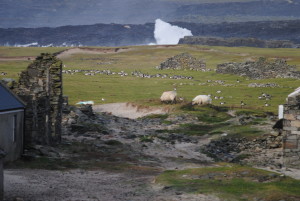
As a field site, the Inishkea Islands are mysterious and intriguing. The last of its inhabitants departed in the 1930s following a devastating storm that killed 10 young fishermen at sea. The ruins of the abandoned village, the sea mists and windswept machair lend the landscape an air of wildness. One thing that cannot be denied is that the islands are a haven for interesting wildlife. In Irish they are called Inis Gé, translating as ‘Goose Islands’, and they don’t disappoint. Large flocks of Barnacle Geese still winter in Inishkea, the population having benefited from the cessation of human habitation. As well as the geese, breeding waders such as Lapwing, Redshank and Snipe (particularly within a sheep exclusion fence on the north island) and seabirds such as Fulmars and Little Terns are present in large numbers, along with a colony of several hundred Grey Seals.
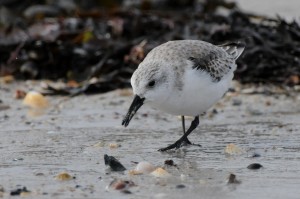
Therefore we eagerly anticipated our chance to take in the spectacle these islands have to offer. But there was serious business to attend to – catching a sufficient sample of geese to add to the study is a task far easier said than done! We used a trapping technique called cannon netting. This is a method for catching ground feeding gregarious birds that is just as weird and wonderful as it sounds! A large net is attached to weighted projectiles, which are fired from a series of mortars, propelling the net (hopefully) over its intended target. Unsurprisingly this is a tightly regulated activity, and only three individuals in Ireland are licenced to catch birds this way and only in specific circumstances.
Our catching attempts on Inishkea were led by Alyn Walsh of the NPWS, helped by Dr Cabot’s knowledge of the islands and goose habits. Working with Alyn was an education in fieldcraft, patience and meticulous preparation. The trick to cannon netting is positioning your net in a place your target species will walk straight into. In our case, the geese had a whole island to choose from, so our positioning had to be spot on. Before a catch was attempted, the movements of the goose flocks were carefully observed for their patterns of grazing, looking for natural choke points in the landscape that would draw the geese together in a suitable position for projecting the nets. Following a day of observation, one promising site was selected and baited with barley to attract and then hold the geese in place. By day three on the island, we were confidently prepared for our first attempt. The net was laid and disguised with grass and its mortars were dug in so that only their tips protruded, in the hope the geese wouldn’t know something was amiss…
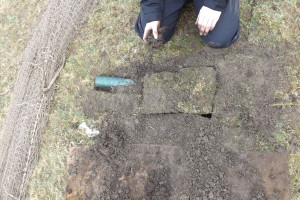
The morning of the catch was akin to the dawn of a battle. Barnacle Geese are not like their more familiar cousin the Brent Goose, which will happily graze in urban parks by busy roads and playgrounds. Barnacle Geese are exasperatingly wary. Any sight of people (even from hundreds of metres away) will send an entire flock off over the horizon. Dr Cabot’s cabin served as our bunker from which we spied on the geese through twitching curtains. Our nerves were on edge as the first goose heads appeared on the brow of the hill and began a steady march grazing towards the catching zone, where the cannons and nets awaited. Any person leaving the single roomed cabin for a ‘comfort break’ was at great risk of alarming the geese. Because of this, we were required to scramble on hands and knees until we reached the cover of the old village, darting from house to house, being sure not to break the skyline and keeping our heads down as if from sniper’s fire.
Having waited in the darkened cabin since dawn, the goose battalion entered our baited field at midday. Lulled into a false sense of security by our extreme stealth and the unexpected windfall of barley, a group of geese fell asleep in the sun – right within our catching zone! They were rudely awoken when (as soon as all birds were in a safe position relative to the cannons) Alyn judged it was time to fire! After two days in the bunker, the blast of the cannons and the smell of gunpowder provided us a suitable adrenaline jolt into manic activity. Following a breakneck sprint to the net, we secured all of the birds safely in special bird-bags (a fantastic catch of 29 geese, the second biggest ever achieved on the island!). To keep handling time to a minimum, we formed a goose “production line” to maximise efficiency in fitting rings, taking morphological measurements and recording data. Processed geese were kept in a holding pen and then released to the wind together in batches of ten. We were lucky to have some geese that had been ringed several years previously, providing valuable data, along with many newly ringed geese.
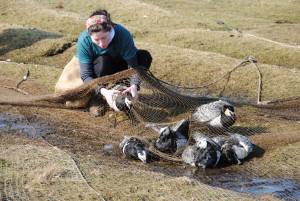
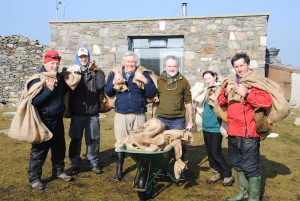
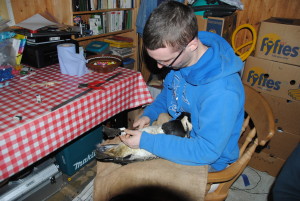
We left Inishkea, satisfied with our work and delighted with our experience in this challenging form of bird monitoring. We hope to see many of the geese we caught this year back in Inishkea with goslings after a successful season in the Arctic.
Authors: Darren O’Connell and Susan Doyle
A special thanks to Dr David Cabot, Alyn Walsh, Richard Nairn, Maurice Cassidy and Christian Glahder, for making us part of the team.

